上海翻译公司中医术语名词英文翻译
- 格式:ppt
- 大小:227.50 KB
- 文档页数:23
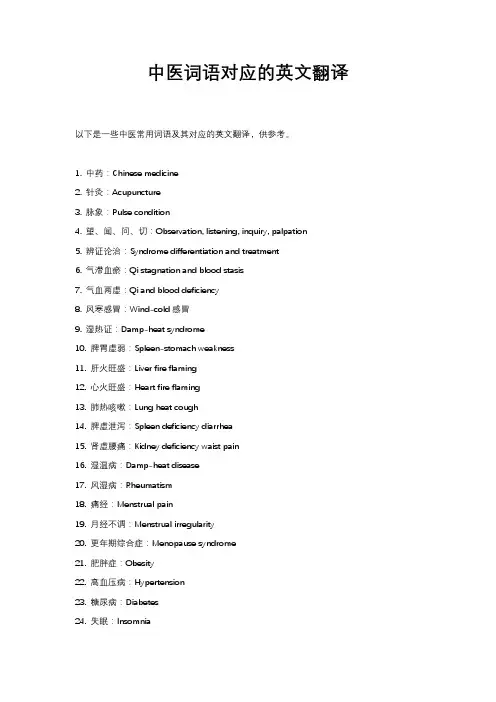
中医词语对应的英文翻译以下是一些中医常用词语及其对应的英文翻译,供参考。
1. 中药:Chinese medicine2. 针灸:Acupuncture3. 脉象:Pulse condition4. 望、闻、问、切:Observation, listening, inquiry, palpation5. 辨证论治:Syndrome differentiation and treatment6. 气滞血瘀:Qi stagnation and blood stasis7. 气血两虚:Qi and blood deficiency8. 风寒感冒:Wind-cold感冒9. 湿热证:Damp-heat syndrome10. 脾胃虚弱:Spleen-stomach weakness11. 肝火旺盛:Liver fire flaming12. 心火旺盛:Heart fire flaming13. 肺热咳嗽:Lung heat cough14. 脾虚泄泻:Spleen deficiency diarrhea15. 肾虚腰痛:Kidney deficiency waist pain16. 湿温病:Damp-heat disease17. 风湿病:Rheumatism18. 痛经:Menstrual pain19. 月经不调:Menstrual irregularity20. 更年期综合症:Menopause syndrome21. 肥胖症:Obesity22. 高血压病:Hypertension23. 糖尿病:Diabetes24. 失眠:Insomnia25. 抑郁症:Depression26. 焦虑症:Anxiety disorder27. 自闭症:Autism28. 强迫症:OCD (Obsessive-Compulsive Disorder)29. 多动症:ADHD (Attention Deficit Hyperactivity Disorder)30. 老年痴呆症:Alzheimer's disease31. 帕金森病:Parkinson's disease32. 癌症:Cancer33. 白血病:Leukemia34. 心脏病:Heart disease35. 肝病:Liver disease36. 肾病:Kidney disease37. 肺病:Lung disease38. 高脂血症:Hyperlipidemia39. 甲亢:Hyperthyroidism40. 甲减:Hypothyroidism41. 黄褐斑:Chloasma42. 白癜风:Vitiligo43. 牛皮癣:Psoriasis44. 带状疱疹:Shingles45. 水痘:Chickenpox46. 麻疹:Measles47. 风疹:Rubella (German measles)48. 痄腮:Mumps (耳下腺炎)49. 红眼病(急性结膜炎):Red eye (acute conjunctivitis)50. 中耳炎:Otitis media (middle ear infection)请注意,这些翻译可能并不完全准确或具体,因为中医是一个非常复杂和深奥的医学系统,其概念和术语往往难以用简单的英文词汇来表达,仅供参考。
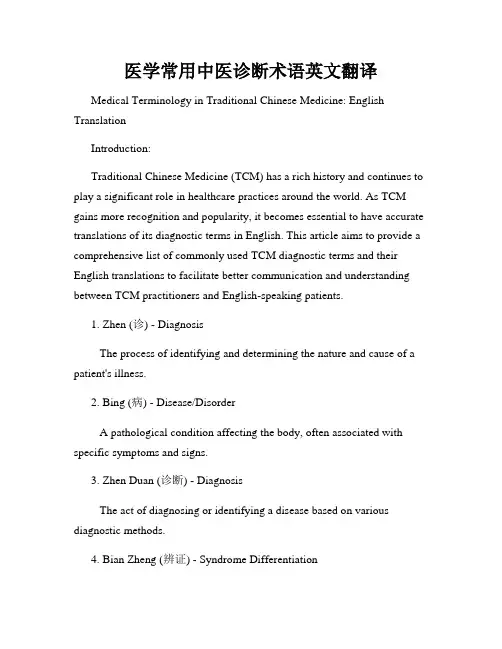
医学常用中医诊断术语英文翻译Medical Terminology in Traditional Chinese Medicine: English TranslationIntroduction:Traditional Chinese Medicine (TCM) has a rich history and continues to play a significant role in healthcare practices around the world. As TCM gains more recognition and popularity, it becomes essential to have accurate translations of its diagnostic terms in English. This article aims to provide a comprehensive list of commonly used TCM diagnostic terms and their English translations to facilitate better communication and understanding between TCM practitioners and English-speaking patients.1. Zhen (诊) - DiagnosisThe process of identifying and determining the nature and cause of a patient's illness.2. Bing (病) - Disease/DisorderA pathological condition affecting the body, often associated with specific symptoms and signs.3. Zhen Duan (诊断) - DiagnosisThe act of diagnosing or identifying a disease based on various diagnostic methods.4. Bian Zheng (辨证) - Syndrome DifferentiationThe process of determining the specific syndrome or pattern underlying a patient's disease.5. Zhen Duan Zhi Shi (诊断指示) - Diagnostic IndicatorsThe symptoms, signs, and other clinical information used in making a diagnosis.6. Wen Bing (温病) - Febrile DiseasesA category of diseases characterized by fever, often caused by external pathogenic factors.7. Wei Qi (卫气) - Defensive QiA form of Qi that protects the body from external pathogenic factors.8. Zheng Qi (正气) - Righteous QiThe body's own vital energy or defensive energy that helps combat diseases.9. Yin-Yang (阴阳) - Yin and YangThe fundamental concepts of TCM, representing the opposing yet interconnected forces that govern the balance and functioning of the body.10. Qi (气) - QiThe vital energy or life force that flows through meridians, responsible for maintaining health and wellbeing.11. Xue (血) - BloodThe vital substance responsible for nourishing the body's organs and tissues.12. Jing Luo (经络) - Meridians and CollateralsThe pathways through which Qi and blood flow in the body, connecting various organs and systems.13. Zang-Fu (脏腑) - Organs and BowelsReferring to the internal organs and their associated functions in TCM.14. Jie (结) - SyndromeA combination of symptoms, signs, and patient history that characterizes a specific disease or condition.15. Bian Bing (辨病) - Disease DifferentiationThe process of identifying and differentiating various diseases based on their specific characteristics.16. Zheng (证) - Pattern/SyndromeA specific pattern or set of symptoms that reflect the nature and location of a disease in TCM.17. Tongue Diagnosis (舌诊) - Tongue ExaminationAssessing a patient's health condition and specific syndromes by observing the color, shape, coating, and moisture of the tongue.18. Pulse Diagnosis (脉诊) - Pulse ExaminationEvaluating a patient's overall health and specific syndromes by palpating the radial pulse for qualities such as rate, rhythm, and strength.Conclusion:Effective communication and understanding between TCM practitioners and English-speaking patients are crucial for optimal healthcare outcomes. This list of commonly used TCM diagnostic terms and their English translations serves as a valuable resource for bridging the language gap and facilitating better communication in the field of TCM. Emphasizing accurate and standardized translations of these terms will enhance the integration and acceptance of TCM within the global healthcare community.。
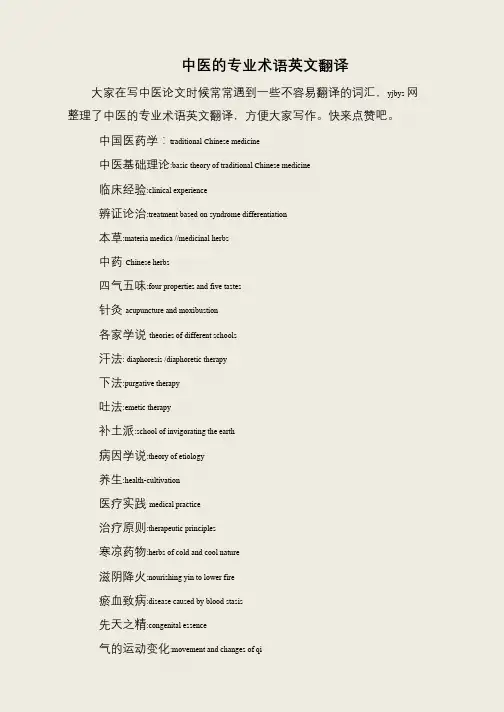
中医的专业术语英文翻译大家在写中医论文时候常常遇到一些不容易翻译的词汇,yjbys 网整理了中医的专业术语英文翻译,方便大家写作。
快来点赞吧。
中国医药学:traditional Chinese medicine中医基础理论:basic theory of traditional Chinese medicine临床经验:clinical experience辨证论治:treatment based on syndrome differentiation本草:materia medica //medicinal herbs中药Chinese herbs四气五味:four properties and five tastes针灸acupuncture and moxibustion各家学说theories of different schools汗法: diaphoresis /diaphoretic therapy下法:purgative therapy吐法:emetic therapy补土派:school of invigorating the earth病因学说:theory of etiology养生:health-cultivation医疗实践medical practice治疗原则:therapeutic principles寒凉药物:herbs of cold and cool nature滋阴降火:nourishing yin to lower fire瘀血致病:disease caused by blood stasis先天之精:congenital essence气的运动变化:movement and changes of qi。
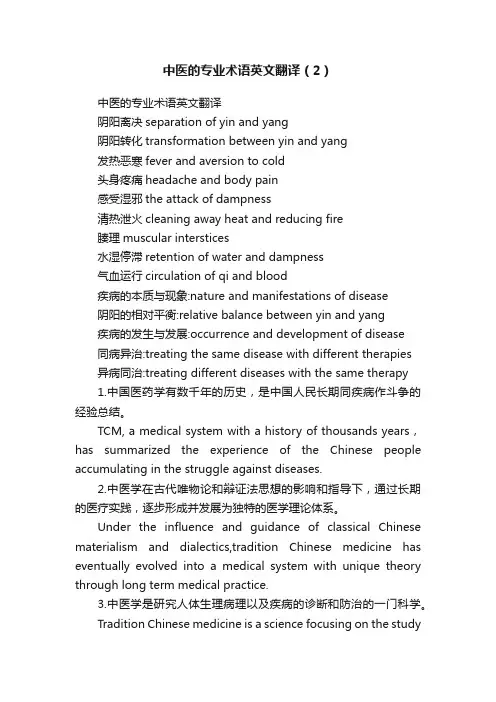
中医的专业术语英文翻译(2)中医的专业术语英文翻译阴阳离决separation of yin and yang阴阳转化transformation between yin and yang发热恶寒fever and aversion to cold头身疼痛headache and body pain感受湿邪the attack of dampness清热泄火cleaning away heat and reducing fire腠理muscular interstices水湿停滞retention of water and dampness气血运行circulation of qi and blood疾病的本质与现象:nature and manifestations of disease阴阳的相对平衡:relative balance between yin and yang疾病的发生与发展:occurrence and development of disease同病异治:treating the same disease with different therapies异病同治:treating different diseases with the same therapy1.中国医药学有数千年的历史,是中国人民长期同疾病作斗争的经验总结。
TCM, a medical system with a history of thousands years,has summarized the experience of the Chinese people accumulating in the struggle against diseases.2.中医学在古代唯物论和辩证法思想的影响和指导下,通过长期的医疗实践,逐步形成并发展为独特的医学理论体系。
Under the influence and guidance of classical Chinese materialism and dialectics,tradition Chinese medicine has eventually evolved into a medical system with unique theory through long term medical practice.3.中医学是研究人体生理病理以及疾病的诊断和防治的一门科学。
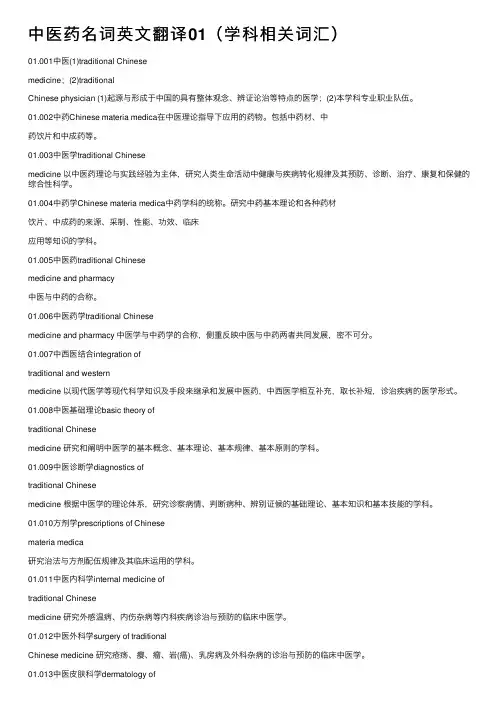
中医药名词英⽂翻译01(学科相关词汇)01.001中医(1)traditional Chinesemedicine;(2)traditionalChinese physician (1)起源与形成于中国的具有整体观念、辨证论治等特点的医学;(2)本学科专业职业队伍。
01.002中药Chinese materia medica在中医理论指导下应⽤的药物。
包括中药材、中药饮⽚和中成药等。
01.003中医学traditional Chinesemedicine 以中医药理论与实践经验为主体,研究⼈类⽣命活动中健康与疾病转化规律及其预防、诊断、治疗、康复和保健的综合性科学。
01.004中药学Chinese materia medica中药学科的统称。
研究中药基本理论和各种药材饮⽚、中成药的来源、采制、性能、功效、临床应⽤等知识的学科。
01.005中医药traditional Chinesemedicine and pharmacy中医与中药的合称。
01.006中医药学traditional Chinesemedicine and pharmacy 中医学与中药学的合称,侧重反映中医与中药两者共同发展,密不可分。
01.007中西医结合integration oftraditional and westernmedicine 以现代医学等现代科学知识及⼿段来继承和发展中医药,中西医学相互补充,取长补短,诊治疾病的医学形式。
01.008中医基础理论basic theory oftraditional Chinesemedicine 研究和阐明中医学的基本概念、基本理论、基本规律、基本原则的学科。
01.009中医诊断学diagnostics oftraditional Chinesemedicine 根据中医学的理论体系,研究诊察病情、判断病种、辨别证候的基础理论、基本知识和基本技能的学科。
01.010⽅剂学prescriptions of Chinesemateria medica研究治法与⽅剂配伍规律及其临床运⽤的学科。

中医药常用名词术语英译1. 嘿,你知道“阴阳”在中医药里怎么英译不?“Yin - Yang”呀。
就好比白天和黑夜,一个是阳,一个是阴,它们相互对立又相互依存呢。
比如说,一个人身体太“阳”了,可能就容易上火,就像夏天太阳太猛,大地都干涸了。
2. 咱来聊聊“气”这个词的英译,“Qi”。
这“气”啊,就像身体里的小发动机。
我有个朋友,老是没精打采的,中医就说他“气”不足。
这“气”在身体里到处跑,推动着身体各个机能运转呢。
3. “经络”的英译是“Meridian”。
这经络就像身体里的高速公路网哦。
我上次去看中医,医生说经络不通会导致很多毛病。
就像高速公路堵了,车就没法顺畅地跑,身体里的气血也一样。
4. “穴位”的英语是“Acupoint”。
穴位就像身体上的一个个小开关。
有次我头疼,中医在我头上的一个穴位按了几下,哎呀,就像打开了止痛的开关一样,立马感觉好多了。
5. “中药”的英译是“Chinese materia medica”。
这中药可神奇啦,就像大自然赐给我们的医药宝藏。
我奶奶生病就爱喝中药,那些草药熬出来的汤,感觉就像把大自然的力量都喝进肚子里了。
6. 你了解“方剂”的英译吗?是“Prescription”。
方剂就像是一个医药团队。
比如说一个治疗感冒的方剂,里面有好几味中药,就像团队里不同的成员,各自发挥着作用,一起把感冒这个“敌人”打败。
7. “炮制”的英语是“Processing”。
这炮制就像给中药做一场精心的改造。
我见过中药师傅炮制药材,把原本普普通通的药材,经过各种工序,就像把一个灰姑娘变成公主一样,药效都变得更厉害了。
8. “辨证论治”的英译是“Treatment based on syndrome differentiation”。
这就像医生当侦探呢。
我去看中医,医生又是看舌头,又是把脉,然后判断我的“证”,再根据这个来治疗。
就像侦探根据线索破案一样精准。
9. “四气五味”的英语是“Four natures and five flavors”。
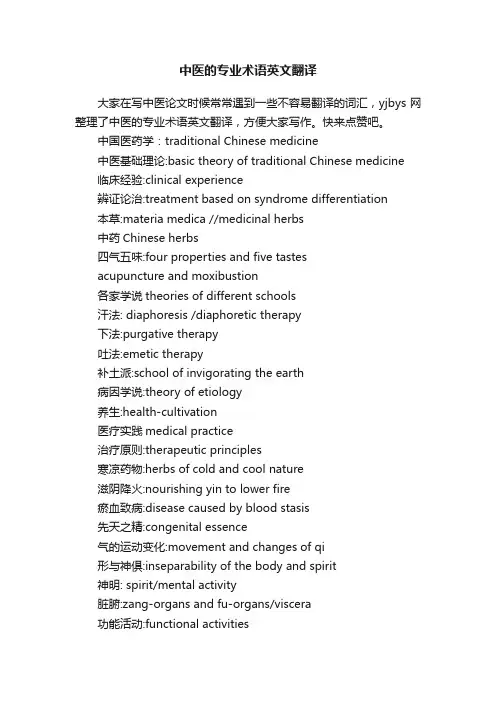
中医的专业术语英文翻译大家在写中医论文时候常常遇到一些不容易翻译的词汇,yjbys网整理了中医的专业术语英文翻译,方便大家写作。
快来点赞吧。
中国医药学:traditional Chinese medicine中医基础理论:basic theory of traditional Chinese medicine临床经验:clinical experience辨证论治:treatment based on syndrome differentiation本草:materia medica //medicinal herbs中药Chinese herbs四气五味:four properties and five tastesacupuncture and moxibustion各家学说theories of different schools汗法: diaphoresis /diaphoretic therapy下法:purgative therapy吐法:emetic therapy补土派:school of invigorating the earth病因学说:theory of etiology养生:health-cultivation医疗实践medical practice治疗原则:therapeutic principles寒凉药物:herbs of cold and cool nature滋阴降火:nourishing yin to lower fire瘀血致病:disease caused by blood stasis先天之精:congenital essence气的运动变化:movement and changes of qi形与神俱:inseparability of the body and spirit神明: spirit/mental activity脏腑:zang-organs and fu-organs/viscera功能活动:functional activities形神统一:unity of the body and spirit阴阳失调:imbalance of yin and yang正邪相争:struggle between healthy qi and pathogenic factors 治未病prevention of disease调养 to cultivate health正气 healthy qi病邪 pathogenic factor疾病的防治 prevention and treatment of disease整体观念 concept of holism五脏five zang-organs六腑six fu-organs经络系统system of meridians and collaterals形神统一unity of the body and spirit有机整体organic wholeness表里关系exterior and interior relation开窍opening into生长化收藏five element function脉象pulse conditions正邪关系the states of pathogenic factors and healthy qi自然现象natural phenomena哲学概念philosophical concept对立统一unity and opposites相互消长mutual waning and waxing阴阳属性nature of yin and yang相互转化mutual transformation相互联系interrelation相互制约mutual restraint动态平衡dynamic balance阴平阳秘yin and yang in equilibrium阳消阴长 yang waning and yin waxing阴胜则阳病predominance of yin leading to disorder of yang 阳胜则热 predominance of yang generating heat寒极生热 extreme cold generating heat热极生寒extreme heat generating cold相反相成 opposite and supplementary to each other生理功能physiological functions病理变化pathological changes临床诊断clinical diagnosis有机整体organic wholeness/entirety正邪斗争struggle between healthy qi and pathogenic factors 绝对偏盛absolute predominance阳虚则寒yang deficiency leading to cold阳损及阴consumption of yang involving yin阴液不足insufficiency of yin-fluid病机pathogenesis五行学说theory of five elements运动变化motion and variation条达舒畅free development相生相克mutual generation and restriction生我我生to be generated and to generate克我我克to be restricted and to restrict生中有制restriction within generation克中有生generation within restriction木曰曲直Wood is characterized by growing freely and peripherally火曰炎上Fire is characterized by flaming up土曰稼穑Earth is characterized by cultivation and reaping金曰从革Metal is characterized by change水曰润下Water is characterized by moistening and downward flowing方位配五行correspondence of the directions to the five elements相乘相侮over-restriction and reverse restriction土乘木The wood over-restrains the earth土虚木乘 Earth deficiency leading to over-restriction by wood 金虚木侮metal deficiency leading to counter-restriction by wood生克制化interrelationship between generation and restriction制则生化restriction ensuring generation传变transmission of disease母病及子disease of the mother-organ affecting the child-organ子病犯母disease of the child-organ affecting the mother-organ肝肾精血不足insufficiency of kidney and liver essence and blood肝阳上亢hyperactivity of liver yang藏象学说 theory of visceral manifestations五脏六腑 five zang-organs and six fu-organs奇恒之府 extraordinary fu-organs水谷精微 cereal nutrients传化水谷 transmissions and transformation of food贮藏精气 storage of essence表里关系 interior and exterior relationship治疗效应 curative effect临床实践 clinical practice藏而不泻 storage without excretion心肝血虚deficiency of heart and liver blood心肝火旺exuberance of heart and liver fire心火亢盛exuberance of heart fire滋肾养肝nourishing the kidney and liver肝阴不足insufficiency of the liver yin温肾健脾warming the kidney and strengthening the spleen 肾阳式微declination of kidney yang脾阳不振inactivation of spleen yang肝旺脾虚hyperactivity of the liver and weakness of the spleen 脾胃虚弱weakness of the spleen and stomach平肝和胃soothing the liver and harmonizing the stomach水湿停聚retention of water-dampness肾阴不足insufficiency of kidney yin心肾不交disharmony between the heart and kidney水火不济discordance between water and fire阴阳俱损simultaneous consumption of yin and yang阴阳两虚simultaneous deficiency of both yin and yang损其有余reducing excess补其不足supplementing insufficiency阴中求阳obtaining yang from yin虚寒证deficiency-cold syndrome扶阳益火strengthening yang to increasing fire祛风散寒eliminating wind to dispersing cold消导积滞promoting digestion and removing food retention 潜阳息风suppressing yang to quench wind阴阳的互根互用interdependence of yin and yang相互依存interdependence。

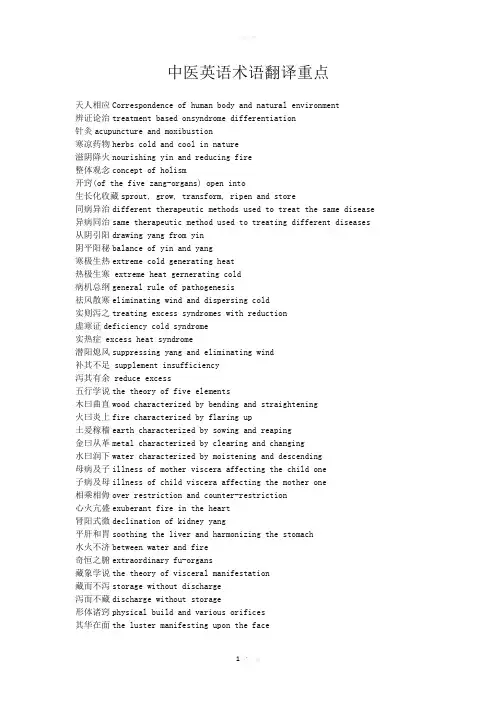
中医英语术语翻译重点天人相应Correspondence of human body and natural environment辨证论治treatment based onsyndrome differentiation针灸acupuncture and moxibustion寒凉药物herbs cold and cool in nature滋阴降火nourishing yin and reducing fire整体观念concept of holism开窍(of the five zang-organs) open into生长化收藏sprout, grow, transform, ripen and store同病异治different therapeutic methods used to treat the same disease 异病同治same therapeutic method used to treating different diseases 从阴引阳drawing yang from yin阴平阳秘balance of yin and yang寒极生热extreme cold generating heat热极生寒 extreme heat gernerating cold病机总纲general rule of pathogenesis祛风散寒eliminating wind and dispersing cold实则泻之treating excess syndromes with reduction虚寒证deficiency cold syndrome实热症 excess heat syndrome潜阳熄风suppressing yang and eliminating wind补其不足 supplement insufficiency泻其有余 reduce excess五行学说the theory of five elements木曰曲直wood characterized by bending and straightening火曰炎上fire characterized by flaring up土爰稼穑earth characterized by sowing and reaping金曰从革metal characterized by clearing and changing水曰润下water characterized by moistening and descending母病及子illness of mother viscera affecting the child one子病及母illness of child viscera affecting the mother one相乘相侮over restriction and counter-restriction心火亢盛exuberant fire in the heart肾阳式微declination of kidney yang平肝和胃soothing the liver and harmonizing the stomach水火不济between water and fire奇恒之腑extraordinary fu-organs藏象学说the theory of visceral manifestation藏而不泻storage without discharge泻而不藏discharge without storage形体诸窍physical build and various orifices其华在面the luster manifesting upon the face满而不实 full but not to be solid实而不满solid but not to be full心主血脉heart governing blood and vessels肺司呼吸lung controlling breathing脾主运化spleen governing transportation and transformation肝主疏泄liver controlling conveyance and dispersion肾主藏精kidney governing storing essence面色无华lusterless complexion汗血同源sweat and blood sharing the same origin升降出入ascending, descending, going out and going in宣发肃降dispersion, purification and descent后天之本acquired base of life肝气逆上upward adverse flow of liver qi先天之精innate essence奇恒之腑extraordinary fu-organs孤俯isolated fu-organ腐熟水谷digest water and food七冲门the seven important portals胆主决断The gallbladder is responsible for making judgment泌别清浊separating the lucid from the turbid大肠主津The large intestine governs thin body fluid小肠主液The small intestine governs thick body fluid先天禀赋innateness温养腑脏warming and nourishing the viscera津血同源body fluid and blood sharing the same origin气为血帅,血为气母Qi commands the blood and the blood carries qi.益气固脱nourishing qi to stop collapse奇经八脉eight extraordinary vessels十二经筋tendons of the twelve regular meridians舒经活络soothing meridians and activating collaterals刺络拔罐collateral pricking and cupping therapy腠理闭塞stagnation of interstitial space湿邪困脾pathogenic dampness obstructing the spleen外感六淫six excesses pathogenic factors饮食劳倦mproper diet and overstrain阳常有余,阴常不足Yang is usually excessive while yin is frequently deficient. 四大经典Four GreatClassic:Huangdi s Canon of Medicine黄帝内经Classic of Difficulties难经Shennong s Classic of Materia Medica神农本草经Rreatise on Cold Damage and Miscellaneous Diseases伤寒杂病论四气four properties:cold,,hot,warm,cool五味five flavors:sour,bitter,sweet,pungent,salty(中药)七情seven conditions of ingredients in prescriptionsSingle effect,mutual reinforcement,mutual assistance,mutual restraint,mutual inhibition,mutual antagonism,mutual suppression寒凉派Liu Wansu-School of Cold and Cool攻下派Zhang Congzheng-School of Purgation补土派Li Gao-School of Reinforcing the Earth滋阴派Zhu Zhenheng-School of Nourishing Yin辛温中药herbs pungent in taste and warm in nature辛凉中药herbs pungent in taste and cool in narure向日为阳,背日为阴The side facing the sun belongs to yang and the reverse side to yin,血液常行的前提条件:心气充沛,血液充盈,脉道通利Normal circulation of blood:abundance of heart qi,sufficiency of blood,vessels are prerequisite.四气;元气primordial qi,宗气pectoral qi,营气nutrient qi,卫气defensive qi 内生五邪;内风,内寒,内湿,内燥,内火Five internal excesses;internal wind.internal cold,internal dampness,inrenal dryness,internal fire内伤七情Internal injury due to sevenemotions;joy,anger,anxiety,thought,sorrow,fear,fright怒则气上,喜则气缓,悲则气消,恐则气下,惊则气乱。
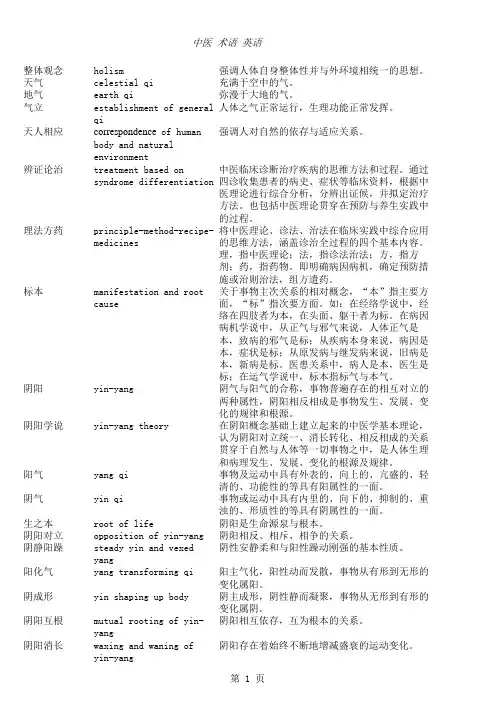
整体观念holism强调人体自身整体性并与外环境相统一的思想。
天气celestial qi充满于空中的气。
地气earth qi弥漫于大地的气。
气立establishment of generalqi人体之气正常运行,生理功能正常发挥。
天人相应correspondence of humanbody and naturalenvironment强调人对自然的依存与适应关系。
辨证论治treatment based onsyndrome differentiation 中医临床诊断治疗疾病的思维方法和过程。
通过四诊收集患者的病史、症状等临床资料,根据中医理论进行综合分析,分辨出证候,并拟定治疗方法。
也包括中医理论贯穿在预防与养生实践中的过程。
理法方药principle-method-recipe-medicines 将中医理论、诊法、治法在临床实践中综合应用的思维方法,涵盖诊治全过程的四个基本内容。
理,指中医理论;法,指诊法治法;方,指方剂;药,指药物。
即明确病因病机,确定预防措施或治则治法,组方遣药。
标本manifestation and rootcause 关于事物主次关系的相对概念,“本”指主要方面,“标”指次要方面。
如:在经络学说中,经络在四肢者为本,在头面、躯干者为标。
在病因病机学说中,从正气与邪气来说,人体正气是本,致病的邪气是标;从疾病本身来说,病因是本,症状是标;从原发病与继发病来说,旧病是本,新病是标。
医患关系中,病人是本,医生是标;在运气学说中,标本指标气与本气。
阴阳yin-yang阴气与阳气的合称,事物普遍存在的相互对立的两种属性,阴阳相反相成是事物发生、发展、变化的规律和根源。
阴阳学说yin-yang theory在阴阳概念基础上建立起来的中医学基本理论,认为阴阳对立统一、消长转化、相反相成的关系贯穿于自然与人体等一切事物之中,是人体生理和病理发生、发展、变化的根源及规律。
阳气yang qi事物及运动中具有外表的、向上的、亢盛的、轻清的、功能性的等具有阳属性的一面。

整体观念holism强调人体自身整体性并与外环境相统一的思想。
天气celestial qi充满于空中的气。
地气earth qi弥漫于大地的气。
气立establishment of generalqi人体之气正常运行,生理功能正常发挥。
天人相应correspondence of humanbody and naturalenvironment强调人对自然的依存与适应关系。
辨证论治treatment based onsyndrome differentiation 中医临床诊断治疗疾病的思维方法和过程。
通过四诊收集患者的病史、症状等临床资料,根据中医理论进行综合分析,分辨出证候,并拟定治疗方法。
也包括中医理论贯穿在预防与养生实践中的过程。
理法方药principle-method-recipe-medicines 将中医理论、诊法、治法在临床实践中综合应用的思维方法,涵盖诊治全过程的四个基本内容。
理,指中医理论;法,指诊法治法;方,指方剂;药,指药物。
即明确病因病机,确定预防措施或治则治法,组方遣药。
标本manifestation and rootcause 关于事物主次关系的相对概念,“本”指主要方面,“标”指次要方面。
如:在经络学说中,经络在四肢者为本,在头面、躯干者为标。
在病因病机学说中,从正气与邪气来说,人体正气是本,致病的邪气是标;从疾病本身来说,病因是本,症状是标;从原发病与继发病来说,旧病是本,新病是标。
医患关系中,病人是本,医生是标;在运气学说中,标本指标气与本气。
阴阳yin-yang阴气与阳气的合称,事物普遍存在的相互对立的两种属性,阴阳相反相成是事物发生、发展、变化的规律和根源。
阴阳学说yin-yang theory在阴阳概念基础上建立起来的中医学基本理论,认为阴阳对立统一、消长转化、相反相成的关系贯穿于自然与人体等一切事物之中,是人体生理和病理发生、发展、变化的根源及规律。
阳气yang qi事物及运动中具有外表的、向上的、亢盛的、轻清的、功能性的等具有阳属性的一面。
AAbdominal flatulence 中满Abdominal fullness and distention 腕痛胀满Abdominal retention 鼓胀Accompanied Symptoms 兼证Activating blood and dissolving stasis 活血化瘀Acuesthesia 得气Acupuncture points 腧穴Acupuncture therapies 针刺疗法Adjuvant drugs 佐药Afternoon fever 日哺发热Alternate chills and fever 寒热往来Anorexia 食欲不振Aphtha 口疮Apoplexy 中风Ashi point 阿是穴Associate drugs 臣药Association of combination of traditional Chinese medicine and western medicine 中西医结合研究会Association of traditional Chinese medicine 中医学会Asthenic cardioyang 心阳虚Asthenic cardioyin 心阴虚Asthma 哮证Otopuncture therapy 耳针疗法Auscultation-olfaction 闻诊Aversion to wind and cold 畏恶风寒BBasis of theory of traditional Chinese medicine 中医理论基础Belching 嗳气Blood deficiency 血虚Blood heat 血热Body fluid 津液CCalming liver wind 平肝熄风Canthus 目眦Carbuncle 痈Cathartic method 攻里法Cardiac and renal coordination 心肾相交Cardiac-splenic asthenia 心脾两虚Chest pain 胸痛Chest stuffiness 胸闷Chi pulse 尺脉Chinese materia medica and pre script ions 中药与方剂Chinese medical 中国医学史Chinese medicine anesthesia 中药麻醉Chinese patent drugs 中成药Clear abundant urine 小便清长Clearing damp 利水渗湿Clearing heat and expectoration 清热化痰Clearing wind-damp 祛风胜湿Clearing Ying heat and cooling blood 清营凉血Coating color 苔色Cold hands and feet 手足厥冷Cold-heat mixing 寒热交错Cold limbs 手足厥冷Cold stroke 中寒Coma 神昏Compendium of Materia Medica 本草纲目Complications 并病Constipation 大便不通Consumptive disease 虚劳Contrary treatment 反治DDefensive Qi instability 卫气不固Deficiency-excess mixing 虚实夹杂Delirium 谵语Diagnostic methods of traditional Chinese medicine 中医诊法Diaphoresis 汗法Diaphoresis, pungent cold 辛凉解表Diaphoresis, pungent warm 辛温解表Diarrhea 泄泻Different treatments for the same disease 同病异治Differentiation, eight principles 八纲辨证Differentiation of diseases 辨病Differentiation of symptoms and signs 辨证Differentiation, six meridians 六经辨证Differentiation, triple energizer 三焦辨证Differentiation, Wei-Qi-Ying-Xue 卫气营血辨证Differentiation, Zang-Fu 脏腑辨证Diphtheria 白喉Diseases of Qi-blood-fluid 气血津液病症Dispersing cold and freeing Bi 散寒通痹Doctrines of various historical schools 中医各家学说Dry heat 燥热Dry stool 大便干结Dysentery 痢疾Dyspepsia 食滞Dysphagia 噎膈Dyspnea 喘证Dysuria 癃闭EEdema 水肿Eight principles 八纲Electuary 冲服剂Elimination 消法Emesis 吐法Endogenous hygrosyndrome 内湿Endogenous cold 内寒Endogenous dryness 内燥Epilepsy 痫证Epitaxis 鼻衄Eruption 斑疹Etiology 病因Exterior syndrome 表证Exterior sthenia 表实Exterior asthenia 表虚Extremely cold limbs 手足厥逆FFacial distortion 口眼歪斜Feeling 按诊Fluid deficiency 津液不足Frequent micturition 小便频数Frequent vomiting 反胃GGastric asthenia 胃虚Gastric cavity 胃脘Gastro-Qi 胃气Generation-inhibition in five elements 五行相克Gingiva 牙龈Greyish fur 灰苔HHarmonizing liver-spleen 调和肝脾Heart fire hyperactivity 心火亢盛Heart-kidney Yang deficiency 心肾阳虚Heart Yang hypoactivity 心阳不振Healthy Qi 正气Hectic fever 潮热Hemorrhage Zheng 血证IInsomnia 失眠Inspection 望诊Intergeneration 相生Inter-restriction 相克Inter-subjuation 相乘Irregular pulse 结代脉KKidney Yang deficiency 肾阳虚Kidney Yin deficiency 肾阴虚LLarge intestine damp-heat 大肠湿热Large pulse 大脉Leukorrhea 白带Liver fire flaming 肝火上炎Liver-stomach disharmony 肝胃不和Liver wind agitation 肝风内动Liver Yang rising 肝阳上亢Liver Yin deficiency 肝阴虚Long pulse 长脉Longer menstrual interval 月经后期Loose stool 便溏Lung heart 肺热Lung Qi deficiency 肺气虚Lung Qi impairment 肺气失宣MMeasles 麻疹Menstrual irregularities 月经失调Merdian-collateral theory 经络学说Meridial distribution 归经Mutual promotion 相须NNight sweat 盗汗Nine orifices 九窍Normal pulse 平脉Nourishing blood and liver 养血柔肝PPale tongue 淡白舌Palpation 切诊Palpitation 心悸Pathogenesis 病机Peeled coating 剥脱苔Pestilence 疫疠Pharynx neurosis 梅核气Phlegm-damp obstructing lung 痰湿阻肺Pill 丸Pores 玄府Principal and subordinate 标本Pulse condition 脉象Pulse-taking 脉诊Purgation-tonifying 攻补兼施QQi-blood and fluid 气血津液Qi deficiency 气虚Qi depression 气滞Qi function 气机RRapid pulse 数脉Relaxing bowels 润肠通便Removing stasis to promote blood circulation 化瘀行血Resolving damp, aromatic 芳香化湿Resuscitation 开窍Retch 干呕Reverse restriction 相侮SSchool in favour of the doctrine of warm diseases 温病学派School of febrile diseases by cold injury 伤寒学派Scrofula 瘰疬Sighing 太息Smallpox 天花Somnolence 多寐Sore 疮Spleen Qi deficiency 脾气虚Spleen Yang deficiency 脾阳虚Spleen Yin deficiency 脾阴虚Spontaneous sweating 自汗Stranguria 小便涩痛Stomach cold 胃寒Stomach heat 胃热Strengthening healthy energy 扶正Striae 腠理Stringy pulse 弦脉Sunstroke 中暑TTenesmus 里急后重Tonifying deficiency 虚则补之Tonifying kidney and holding Qi 补肾纳气Tonifying Qi and spleen 益气健脾Treating excess with purgation 实则泻之Treatment with syndrome differentiation 辨证论治Twenty-eight pulses 二十八脉UUlcer 溃疡Urinal incontinence 小便失禁Uterus 女子胞VVitaport 命门WWhitish fur 白苔Whooping cough 百日咳YYellowish fur 黄苔Ying and Yang in balance 阴平阳秘ZZheng 证一阳"frist yang, Shaoyang Channel"一阴"frist yin, Jreyin Channel"一逆one mista ade in treatment一息respiration一侧的unilateral一日量daily dose一服药a dose of medicine一夫法finger breadth measurement一身痛重general pain and heaviness乙癸同源Yi(the live) and Gui)the Kidney) bejing the same source二阴"two lower orifices, ie, the external urethral orifice and the anus" 二浊reddish and whitish turbid urine二十八脉twenty-eight kinds of pulse condition二阳并病Shaoyang syndrome complicated by T aiyang syndrome二便不利difficulty in urination and defecation二便失禁urinary and fecal incontinence十问inquire about ten aspects of the patient十剂ten kinds of pre script ion十八反eighteen incompatible medicaments十二剂twelve kinds of pre script ion十二节twelve joints十二禁twelve contraindications十二经twelve regular channels十二时traditional twelve two-hour periods十二脏twelve internal organs十二怪脉"ten moribund pulses, ten kinds of paradoxical pulse condition" 十九畏nineteen nedicaments of nutual antagonism十三科the thirteen medical specialties十四经the fourteen channels十五络(脉)fifteen main collaterals十二节刺twelve methods of needling十二经别branches of the twelve regular channels十二经筋muscle along the twelve regular channels十二皮部twelve skin areas十六郄穴sixteen cleft points十四经穴"accupuncture points on the fourteen regular channels, acupoints on regular channels"十五络穴fifteen main collaterals points十二经动脉arteries of the twelve channels十二井穴twelve well-points十二经之海sea of the twelve channels丁痂scar丁奚疳infantile malnutrition due to excessive feeding丁躬势bowing丁字形骨折T-shaped fracturre七方"seven pre script ions, Seven formulae"七恶the symtoms and signs indicating poor prognosis of suppurative infections of the exterior part of the body七窍seven orifices七情seven emotions七疝seven kinds of hernia七伤 1.seven kinds of impairments 2.seven symptoms suggesting consumption of the kidney-qi七冲门seven important portals七怪脉"seven moribund pulses, seven paradoxical pulse conditions, seven fatal pulse conditions"七日风=脐风neonatal tetanus七星针=梅芬针seven star needle八纲the eight principal syndromes serving as guidelines in diagnosis八法eight therapeutic methods八廓the eight regions of the white of the eye八溪eight joints八会穴"eight hui-points, eight influential points"八片锦different pictures of superficial venules of index finger in children as a reference for diagnosis八纲辨证analyzing and differentiating pathological conditions in accordance with the eight principal syndromes八脉交会穴eight confluence points人中疔boi on philtrum人咬伤human bite; bite by man人迎脉Renying pulse人背复位back-carrying reduction人痘接种human variolation人工牛黄"artificial ox gallstone, Calculus Bovis Factitius"人事不省=神昏unconsciousness入臼joint reduction儿风eclampsia儿病=恶阻儿茶"catechu, blzck catechu, Catechu"儿枕痛after-pains儿捧母心breech presentation儿科四大要证four chief diseases in pediatrics九刺nine types of needling九气nine kinds of illness due to disturbance of qi九窍nine orifices九脏nine internal organs九虫病parasitic diseases九窍出血bleeding from the nine orifices九六补泻法nini-six reinforcing-reducing method刀伤incised wound刀晕traumatic syncope刀创伤drug for incised wound刀斧伤wound by knife or ax三宝"three exxentialsessence, qi and configurative force"三痹three types of arthralgiz三刺=齐刺three-stratum puncture三法"three therapeutic methods-diaphoresis, emesis, and purgation" 三伏"1.three periods of dog days, 2.the third period of dog days"三关the three passes三焦"tri-jiao, sanjiao, triple warmer, triple heater"三毛(丛,聚)clump hair三品three grades of medicines三消three types of diabetes三因three categories etiologic factors三虫病three intestinal parasitoses三春柳=柽柳三焦病disease of tri-jiao三焦经Tri-jiao Channel三焦咳tri-jiao cough三棱针"three-deged needle, tri-ensiform needle"三陷证three typesof inward penetration of pyogenic agent三阳病disease of the three yang channels三阳经three yang channels三阳络Sanyanglo三阴病diseases of the three yin channels三阴经three yin channels三阴痉convulsion with symptoms of three yin channels三阴疟three-yin malaria三板疗法"tri-tabular massage, massage with three Kinds of boards"三部九候three portions and nine pulse-takings7 三焦辨证differentiation of syndrome according to the pathological changes of trijiao 三焦实热heat in tri-jiao of excess type三焦虚寒cold syndromes of deficiency type三阳合病disease involving all three yang channels三点挤压法three-point pressure method三焦主决渎the triple warmer manages the dredging of water pathway干便dry stool干疽cellulitis at the anterolateral aspect of the shoulder干咳"dry cough, unproductive cough"干呕retching干陷dry type of inward penetation of pyogenic agent干癣1.chronic eczema 2.neurodermatitis干皮dried bark干血劳emaciation due to blood disorders干胁痛dry hypochondriac pain干脚气dry beriberi干霍乱dr cholera干眼症xerophthalmia干拔罐1.dry cupping 2.ordinary cupping土earth(in five elements)土方"folk recipe, local recipe"土疳=针眼hordeolum土栗infection of the heel土风疮popular urticaria土生甘sweet flavour is attributed to earth土生金earth generates metal土克水earth restricts water土脯子mantis cheeks土乘水earth subjugates water土不制水earth fails to control water土生万物earth produces myriads of things土喜温燥earth prefers warmth and dryness土郁夺之Dampness accumulated in the spleen(earth) should be removed8 下胞Lower eyelid下膊forearm下法"purgation, purgative therapy"下疳chancre下膈intake of food in the morning and vomiting in the evening下工"an inferior medical worker, an inexperienced healer"下骨sending down the fishbone下极1.anus 2.perineum 3.area between inner canthi 4.another name for Hengku下焦"lower-jiao, lower warmer, lower heater, lower burner"下利diarrgea下迫tenesmus下气"1.a therapeutic mithod to keep the adverse qi flowing downward 2.aerofluxus, breaking wind 3.qu of the lower part of the body"下窍lower orifices下泉urine下乳=催乳lactogenesis下脘1.phlorus 2.Hsiawan下陷=中气下陷descending disorders下消"diabetes of the kindney type, diabetes incolving the lower-jiao"下搭手lower back cellulitis下丹田lower elixir field下发背"lumbar carbuncle, deep-rooted ulcer in the lumbar region"下焦病lower-jiao syndrome下马痈acute pyogenic infection of right下石疽indurated mass of knee下牙床mandible下注疮eczema of shank下病上取treating diseases of the lower part of the body by needling points on the upper part of the body下腹胀气flatulence in the lower abdomen下汲肾阴consumption of the kidney-yin by the excessive heart fire下焦如渎lower-jiao resembling water passages下焦主出The Lower-jiao is in charge of excretory system下厥上竭exharstion of blood with cold limbs下厥上冒dizzeness caused by adverse flow of qi下利清谷diarrhea with undigested food in the stool下损及上dusease in the lower part affecting the upper下胎毒法dispelling toxic heat and meconium gathered at the fetus for the new born下者举之Sinking disorders should be treated with drugs of raising property; prolapse and ptosis must be treated with the lifting method to reinforce the vital function of the spleen 下焦湿热downward flow of damp and heat下利赤白dysenteric diarrhea下横骨伤fracture of public bone下行通路descending pathway 最新回复zzzxxx001 at 2007-7-06 22:45:43大夫"an official's title in the feudal age, now used for a doctor in northern China"大肠large intestine大毒extremely poisonous drugs大方heavy pre script ion大分distinct line between large muscles大风= 麻风大腹upper abdomen大谷large space between muscles大汗"profuse sweating, byperhidrosis, excessive perspiration"大经rge channels 2.the needling of points on a large channel exhibiting symptoms 大厥coma大络large collatereals大脉"large pluse, gigantic pulse"10 大衄profuse bleeding from the mouth and nose大气"atmosphere, air"大溲(解)"defecation, bowel movements"大泻vigorous reduction大医respected doctor大针large needle大眦=内眦great canthus大节large joints大产eutocia大便feces; stool;defecation大耳mycrotia大肉large muscles大嘴macrostomia大肠病disease of large intestine大肠经"Large Intestine Channel, LI"大肠虚asthenia of large intestine大肠痈acute appendictis大肠胀flatulence of large intestine大方科speciality of internal medicine大瘕泄dysentery大结胸large accumulation of phlegm-heat in the chest大头垫megacaput pad大头风=大头瘟infection with swollen head大腿疽=股疽大腿痈carbuncle of thigh大泻刺drainage needling大指间web of great toe大周天large cirde of vital energy大眦漏=漏睛dacryocystitis大方脉adult's pulse大出血"massive hemorrhage,hematorrhea"大肠气inguinal hernia大麻风"lepra, leprosy"大便溏loose stool大补元气invigorating primodial qi大肠寒结constipation due to retention of cold-pathogen in large intestine大肠滑脱prolapse of rectum大肠气滞qi stagnation of large intestine大肠热结large intestinal11 大肠湿热large intestinal damp-heat大肠虚寒asthenia-cold of large intestine大肠液亏deficiency of fluid in large intestine大方脉科internal medicine大风恶疫=麻风大肉陷下obvious emaciation and muscular atrophy大头伤寒=大头瘟大眦脓漏dacryocystitis with pyorrhea大气疗法aerotherapy大风荷毒most dangerous pathogenic factors大肠津亏fluid deficiency in the large intestine大便干结dry stool大便不通constipation大便色黑"black stool, melena"大便如漆tarry stools大便失禁incontinence of feces大便困难dyschesia大便频数frequency of bowel movement大汗淋漓profuse perspiration大骨枯槁bones become dry and brittle大渴引饮extreme thirst大肠主传导large intestine takes charge of transportation大实有羸状appearance of deficiency in extreme excess兀兀欲吐intense nausea万灵药panacea寸a length measurement corresponding to the middle segment of one's middle finger 寸脉cun pulse寸口脉cunkou pulse寸白虫proglottid of tapeworm寸白虫病taeniasis寸、关、尺"cun,guan,and chi,inch,bar,and cubit"上胞upper eye lid上膊upper arm上膈"postcibal vomiting,vomiting immediately after in gestion"12 上工"Shang-gong,superior medical worker"上火sufering from excessive internal heat上焦"upper-jiao,upper warmer,upper heater"上气1.abnormal rising of qi 2.the upper qi上窍upper orifices上脘1.shangwan 2.episgastrium上消diabetes involving the upper-jiao上搭手cellulitis near the scapular region上丹田upper elixir field上腭痈abscess on palate上耳背Shangerpei上发背suppurative inflammation of the uppermost part of the back上横骨sternal notch上马痈left buttock carbuncle上石疽upper stony mass behind the ear上水鱼abscess of the popliteal region上牙床upper dental bed上肢瘫paralysis of upper extremities上焦证upper warmer syndrome上胞下垂"ptosis,blepharoptosis"上病下取treating diseases in the upper part by managing the lower上膈下膈upper stenosis and lower stenosis上寒下热cold in the upper and heat in the lower上焦病症syndrome of the upper-jiao上焦如雾the upper-jiao resembling a sprayer上焦主纳The upper-jiao is in charge of receiving上骱手法reduction of dislocation上厥下竭syncope due to exhaustion below上气喘促shortness of breath上热下寒heat in the upper and cold in the lower上实下虚excess in the upper and deficiency in the lower上损及下the upper effecting the lower上吐下泻vomiting and diarrhea上下配穴"coordination of the acupionts of the upper with those of the lower, superior-inferior point association"上虚下实deficiency in the upper and excess in the lower上肢不遂moter impairment of the upper extremities上翘下钩势dorso-extension and ventro-flexion exercise口"mouth,oral cavity"口臭"foul breath, halitosis"口疮"aphthae,canker sore"口淡tastelessness口服"per oral,per os"口疳aphthae in children口紧=唇紧口噤"lockjaw, trismus"口苦bitter taste口软flaccidity of mouth in infants口水"saliva,spittle"口酸sour taste口{口呙} wry mouth口咸salty taste口吃"stutter,stammer"口糜erosion of mucous membrance of the oral carity口渴thirst口不仁numbness of mouth口齿科specialty of stomatology and dentistry口甘甜sweet taste口疳风=舌头泡blisters of the tongue口丫疮"ulcer on the angle of lips,perleche"口中和normal sense of mouth口臭口烂halitosis and aphthosis口唇发紫cyanotic lips口唇紧缩=唇紧口干唇裂dry mouth with cracked lips口噤唇青trismus with cyanotic lips口舌糜烂aphthous stomatitis14 口涎外溢"1.involuntary drooling 2.sialorrhea,ptyalism,sialism,excessive flow of saliva" 口眼{口呙}斜"1.facia hemiparalysis deviation of the eye and mouth, wry mouth with distorted eyes"口中无味=口淡flat feeling in mouth口干唇燥dry mouth and lips口不知谷味loss of appetite口齿咽喉科"1.Department of the Mouth, Teath and Throat 2.specialty of mouth tooth-throat" 口沃沫多唾excessive salivation with froth千日疮verruca vulgaris千岁疮=流注疮widespread scrofula久咳chronic cough久痢protracted drsentery久疟chronic malaria久痔=肛漏recto-analfistula久泻chronic diarrhea久热伤阴persistent fever injuring yin essence久不受孕fail to be impregnated for a long time久泻不止chromic diarrhea丸剂"pill,bolus"广肠sigmoidorectum广疮=杨梅疮syphilis广明anterosuperior part of the human body丫叉毒丫刺毒pustule in the web between the fiest and second metacarpals亡血"hemorrhage, bleading"亡阳"yang depletion,yang exhaustion"亡阴"yin depletion,yin exhaustion"亡血家patient with hemorrhagic diathesis尸厥corpse-like syncope尸体"corpse,cadaver"尸咽"ophthalmo-oro-genital syndrome,Behcet's syndrome"卫defensive function卫气defensive energy卫分证" weifen syndrome,febrile disease at wei phase,syndrom of wei system"卫生局"health bureau, sanitary bureau"卫生学sanitary science卫气不固=表气不固wei-energy fail to protect the body卫气同病"syndrome of both weifen and qufen,syndrome of both qi and wei systems"卫气管血辨证analysing and differentiating the development of an epidemic febrile disease by studying condition of the four systems女科"1.women's diseases,gynecology and obster\trics 2.medical department for women,department of gyhecology and obstetrics"女医1.woman physician 2.physician who attends to women's diseases女劳疸jaundice due to sexual intemperance女劳复relapse of disease due to intemperance in sexual life女子胞uterus女阴溃疡ulcerative vulvitiszzzxxx001 at 2007-7-06 22:46:39小产"abortion, miscarriage"小肠the small intestine小毒"d toxicity 2.drugs with a little toxicity,slightly poisonous drugs"小方"minor pre script ion,minor or mild pre script ion"小分small space between muscles小腹=少腹lower abdomen小逆minor mistake in treatment小溲urine小溪=溪谷小心=心包络=命门小眦"lateral canthus, external canthus"小耳microtia小眼microphthalmus小嘴microstomia小便"urine, urination, micturition"小肠病disorder of the small intestine16 小肠经=手太阳小肠经small intestine channel小肠咳"small intestine cough, cough accompanied by flatulence"小肠疝[气] hernia小肠痈small intestinal abscess小肠胀flatulence of the small intestine小方科specialty of pediatrics小腹满distension of lower addomen小夹板splintlet小结胸accumulation of phligm-heat in the chest小伤寒"common cold, common cold of wink-cold type"小舌头uvula小腿疽=胫疽leg cellulitis小中风faint小周天a small circle of the evolutive小眦漏fistula in the lateral canthus小方脉infantile pulse小腹疽(痈)carbuncle of lower abdomen小便短赤scanty dark urine小便短小oliguria小便黄赤dark urine小便辣痛ardor urine小便淋沥dribbling urination小便涩痛difficulty and pain in micturition小便灼热burning sensation during urination小肠实热excessive heat in the small intestine小肠虚寒hypofunction of the small intestine with cold manifestations小儿暴惊sudden fright in children小儿表热exterior-heat syndrome in children小儿虫吐parasite vomiting in children小儿喘急dyspnea in children小儿卒利acute infantile diarrhea in children17 小儿扎目incessant winking of eyes in children小儿发热fever in children小儿发痧eruptive disease in children小儿疳眼eye disorder due to malnutrition in children小儿寒吐vomiting in children due to cold小儿脚拳1.infantile pedal spasm 2.spasm of toes in children小儿惊吐vomiting in children induced by frightening小儿咳逆choking cough in children小儿客忤convulsive seizure in duced by terror in children小儿羸瘦emaciation in children小儿里热endopathic heat syndrowme in children小儿脉法pulse-taking in children小儿热吐vomiting in children due to heat小儿实热heat syndrome of excess type in children小儿食积infantile indigestion with food retention小儿手拳contracture of fingers in children小儿瘫痪infantile paralysis小儿痰鸣wheezing cough in children小儿通睛"esotropia in children, convergent strabismus in children"小儿吐泻vomiting and diarrhea in children小儿哮喘asthma in children小儿虚热heat syndrome of deficiency type in children小儿遗溺(尿)"1.incontinence of urine in children 2.bed-wetting, nocturnal enuresis in children"小儿脉科specialty of pediatrics小户嫁痛pain in vagina小溲热赤dark urine with burning sensation小腿转筋spasm of calf小儿夜啼nocturnal fretfulness infinfants小儿疳积mallnutrition and indigestion syndrome in children18 小儿浮肿edema in children小儿痢疾dysentery in children小儿感冒common cold in children小儿痢证epilepsy in children小儿淋证infection of urinary system in children小儿风水acute glomerular小儿血虚anemia in children小儿自汗"spontaneous perspiration in children, hyperhidrosis in children"小儿咳嗽cough in children小儿腹痛abdominal pain in children小儿无耳anotia小便不利"dysuria, difficulty in micturition"小便不禁=小便失禁"incontinence of urine, aconuresis"小便淋沥dripping discharge of urine小便频数frequency of micturition小儿暑热(渴)证summer fever of children小儿痰湿吐"vomiting in children, due to phlegmdampness"小肠主受盛small intestion has a function of reception小腹中痞块mass in the lower abdomen小儿涕液不收incessant running nose in children小儿推拿疗法infantile massage小儿囟门不合non-closure of fontanels in infants小儿时行痿poliomyelitis小儿遗毒烂斑congenital syphilis飞痘pustules from smallpox vaccination飞法flying method飞疡(扬)喉hematoma of uvulla飞腾八法=灵龟八法the eight magic turttle techniques飞蚊幻视muscae volitantes叉喉风acute laryngeal disorder with compressive feeling in the throat19 马牙1.gingival cyst of mucous gland in the newborn 2.yellowish eruptions on the gum of the newborn马桶癣contact dermatitis of buttock马脾风acute asthmatic attack in children马蹄针staple puncture马刀侠瘿sabre and beadstring scuofulae马蜞咬伤bite by leech子烦restlessness during pregnancy子户=气穴子淋stranguria during pregnancy子满gestational edema子门cervical orifice of uterus子气1.qi of the child organ 2.edema of legs in pregnancy子舌=重舌子嗽=妊娠咳嗽intractable cough during pregnancy子痫(冒)eclampsia gravidarum子悬"upward flow of fetusqi, feeling of distension in the thorax during pregnancy" 子喑"gestational aphonia, aphonia during pregnancy"子痈acute or chronic orchitis and epedidymitis子脏=女子胞医学翻译子肿edema during pregnancy子宫石womb stone子宫痛uterismus子母痔prolapsed internal hemorrhoids子病及母disorder of the child organ affecting the mother organ子肠不收=子宫脱(垂)出uterine prolapse子盗母气illness of the child organ may involve the mother organ子户肿胀swelling of vulva子死腹中=死胎不下dead foetus in the uterus子午捣臼zi wu dao jiu needli绪论introduction中医学traditional Chinese medicine (TCM)中医学理论体系theory system of TCM中医基础理论basic theory of TCM整体观念holism concept五脏一体观holism of five ogans形神一体观holism of body and spirit天人一体观holism of human beings and universe医学模式medical pattern辨证syndrome differentiation论治treatment variation疾病disease证候syndrome症状symptom体征physical sign辨病disease diagnosing同病异治different treament for the same disease异病同治the same treatment for the different disease第一章中医学的哲学基础Ancient philosophic basis of TCM精jing(as the world origin in ancient philosophy)气qi(as the world origin in the ancient philosophy)精气学说theory of jingqi生命life中介medium气机qi activity气化qi transformation感应induction水地说hypothesis of jing originating from water and earth云气说hypothesis of qi originating from cloud and air气一元论monism of qi元气一元论monism of qi阴阳yinyang; yin and yang阴阳学说theory of yinyang阴阳对立inter-opposition between yin and yang阴阳互根inter-dependence between yin and yang阴阳消长wane and wax between yin and yang阴阳交感inter-induction between yin and yang阴阳互藏inter-containing between yin and yang阴阳转化inter-transformation between yin and yang阴阳自和reestablishment to yin-yang equilibrium阴阳平衡both yin and yang in equilibrium五行five elements五行学说theory of five elements五行相生inter-promotion of five elements五行相克inter-inhibition of five elements五行制化relationship of promotion and restriction of five elements 五行相乘inter-invasion of five elements五行相侮reverse restriction in five elements五行胜复resistance of oppressed elements母病及子mother-organ diorder involving its child-organ子病及母child-organ disorder involving its mother-organ滋水涵木replenishing water to nourish wood培土生金reinforcing earth to generate metal益火补土tonifying fire to supplement earth金水相生mutual generation between metal and water抑木扶土inhibiting wood and strengthening earth培土治水cultivating earth to control water佐金平木assisting metal and calming wood泻南补北purging the south (fire) and nourishing the north (water) 宏观观察obsevation on macroscopic level中和golden mean类比analogy第二章藏象Viscera state藏象viscera state藏象学说doctrine of viscera state脏腑viscera; zangfu organs五脏five zang organs心heart肺lung脾spleen肝liver肾kidney六腑six fu organs胆gall baldder胃stomach小肠small intestin大肠large intestine三焦tri-jiao; sanjiao膀胱urinary blader奇恒之腑extraordinary fu organs脑brain髓marrow骨bone脉vessel女子胞uterus满而不实full of essence without foodstuff实而不满full of foodstuff without essence心主神明heart controlling mental activities心主血脉heart controlling blood circulation心藏神heart storing spirit肺主气lun governing qi肺主呼吸之气lung governing respiratory qi肺主一身之气lung governing physical qi肺朝百脉convergence of vessels in the lung肺主行水lung governing water metabolism肺主治节lung governing coordinative activities of viscera肺为华盖lung being the canopy肺为娇脏lung being the delicate organ肺主宣发肃降lung controlling dispersing outward and inwards 气门pore后天之本source of acquired constitution脾主运化spleen governing transportation and transformation 脾气主升spleen governing ascending脾主统血spleen governing blood脾喜燥恶湿spleen preferring dryness to dampness。
中医常用术语英文翻译[学科]中医①traditional Chinese medicine②traditional Chinesephysician①中医学的简称。
②本学科专业职业队伍。
中药Chinesemateria medica在中医理论指导下应用的药物。
包括中药材、中药饮片和中成药等。
中医学traditionalChinese medicine以中医药理论与实践经验为主体,研究人类生命活动中健康与疾病转化规律及其预防、诊断、治疗、康复和保健的综合性科学。
中药学Chinese materiamedica中药学科的统称。
研究中药基本理论和各种药材饮片、中成药的来源、采制、性能、功效、临床应用等知识的学科。
中医药traditionalChinese medicine and pharmacology本草:Materia medica中药:Chinese materiamedica,Chinese medicinals(包括植物药、动物药、矿物药等)中草药:Chinese HerbalMedicine,Chinese medicinal herbs中药学:Chinese pharmaceutics药材:Medicinalsubstance(material)中西医结合integration of traditional and western medicine中医基础理论basictheory of traditional Chinese medicine中医诊断学diagnostics of traditional Chinese medicine方剂学prescriptions of Chinese materia medica,Traditional Chinese Medical Formulae/ prescriptions中医内科学internal medicine of traditional Chinese medicine [阴阳]The Theory of Yinand Yang阴阳对立:Opposition of yin andyang阴阳制约:Restriction of/between yin and yang阴阳互根:Interdependence ofyin and yang阴阳消长:Waxing and waning ofyin and yang阴阳转化:Inter-transformationof yin and yang[五行学说]The Theory of FiveElements五行:water,fire,wood,metal,soil生:promote, generate,engender克:act, restrict,restrain乘:overact,over-restrict, over-restrain, subjugate, overwhelm 侮:counteract,counter-restrict, counter-restrain, rebel[整体观念]concept of organicwholeness辩证法dialectics生长化收藏sprouting, growth,transformation,ripening,storage内外环境统一性the unity betweenthe internal and external environments机体自身整体性the integrity of thebody itself古代唯物论和辩证法classic Chinesematerialism and dialectics 矛盾统一the contradictoryunity互相联系、相互影响related to each otherand influence each other标本Biao (secondaryaspect) and Ben (primary aspect)本质与现象nature and phenomena矛盾的普遍性和特殊性universality andspeciality of contradictions寒者热之Cold disease shouldbe treated by warm therapy热者寒之warm disease shouldbe treated by cold therapy虚者补之deficiency syndromeshould be treated by tonifying therapy实者泻之excess syndromeshould be treated by purgation therapy治病必求其本Treatment ofdiseases must concentrate on the root cause同病异治treatment ofthe same disease with different therapeutic methods异病同治treatment ofdifferent diseases with the same therapeutic method[精气神]清阳为天The lucid Yangascends to form the heaven浊阴为地The turbid Yindescends to constitute the earth气化Qitransformation升降出入ascending,descending, going out, coming in出入废则神机化灭,升降息则气立孤危。
中医术语英文大全以下是一些常见的中医术语及其对应的英文译名:1. 中医 (Traditional Chinese Medicine)2. 针灸 (Acupuncture and Moxibustion)3. 按摩 (Massage)4. 草药 (Herbal Medicine)5. 中药 (Traditional Chinese Medicine)6. 推拿 (Tuina)7. 食疗 (Diet Therapy)8. 气功 (Qigong)9. 气血 (Qi and Blood)10. 经络 (Meridians)11. 寒热 (Cold and Heat)12. 脉象 (Pulse Diagnosis)13. 五行 (Five Elements)14. 通脉散结 (Promoting Qi Circulation and Resolving Stagnation)15. 疏肝理气 (Soothing the Liver and Regulating Qi)16. 补肾固本 (Tonifying the Kidneys and Strengthening the Essence)17. 温阳散寒 (Warming Yang and Dispelling Cold)18. 疏风清热 (Dispelling Wind and Clearing Heat)19. 透疹退湿 (Promoting Eruption and Resolving Dampness)20. 润肺止咳 (Moistening the Lungs and Stopping Cough)这只是一小部分中医术语的英文译名,由于中医涉及的领域广泛且复杂,还有许多其他的中医术语没有在列表中列出。
常见中医术语英文翻译及中文释义-CAL-FENGHAI.-(YICAI)-Company One1郑州市管城中医院肿瘤科整理常见中医术语英文翻译及中文释义常见中医术语英文翻译及中文释义中医术语的中英文参考对照治则 principle of treatment 在对临床的具体立法、处方、用药等具有普遍的指导意义,因而在治疗疾病时必须遵循的基本原则。
治病求本 treatment aiming at its pathogenesis 针对产生疾病的根本原因进行治疗的原则。
急则治标 symptomatic treatment in acute condition 与缓则治本相对而言,在大出血、暴泻、剧痛等标症甚急的情况,及时救治标病。
缓则治本 radical treatment in chronic case 与急则治标相对而言,针对病势缓和、病情缓慢的情况,从本病的病机出发,采取调理、补益为主的治疗原则。
标本兼治 treating both manifestation and root cause of disease 针对病证出现的标本并重的情况,采用治标与治本相结合的治疗原则。
治未病 preventive treatment of disease 采取一定的措施防止疾病产生和发展的治疗原则,包括未病先防和既病防变两个方面。
同病异治 treating same disease with different methods 表现相同的病证,可因人、因时、因地的不同,或由于病情的发展、病机的变化、病型的各异、正邪消长等差异,采取不同治法的治疗原则。
异病同治 treating different diseases with same method 表现不同的病证,由于发病机理相同,采取相同治法的治疗原则。
因时制宜 treatment in accordance with seasonal conditions 考虑到时令气候寒热燥湿的不同而选择适宜的治法、方药的治疗原则。
气随液脱depletion of fluidinvolving qi desertion 大汗、大吐、大泻,使津液大量丢失,气亦随津液大量外泄而脱失的危重病理变化。
气阴两虚deficiency of both qiand yin气虚和阴虚同时并见的病理变化。
内风endogenous wind又称“肝风内动”,“虚风内动”。
指由脏腑机能失调而引起具有动摇、震颤特点之各种症状的病理变化,与肝脏关系最为密切。
包括阴虚风动、肝阳化风、血虚生风、热极生风等。
风胜则动predominate wind causingmotion 风邪侵袭,或肝风内动,出现头目肢体动摇、震颤等的病理变化。
阴虚风动stirring wind due to yindeficiency 肝肾阴液枯竭,筋脉失养而风气内动的病理变化。
肝阳化风hyperactive liver yangcausing wind 肝肾阴亏,水不涵木,肝阳亢逆无制而动风的病理变化。
热极生风extreme heat causingwind 邪热炽盛,伤及营血,燔灼肝经,筋脉失养而挛急抽搐的病理变化。
血虚生风blood deficiency causingwind血液亏虚,筋脉失养,虚风内动的病理变化。
血燥生风blood dryness causingwind 血虚津亏,失润化燥,肌肤失于濡养而致干燥瘙痒及脱屑的病理变化。
痰瘀生风phlegm stasis causingwind 痰与瘀血壅阻经络,阻碍气血,使脏腑功能失常而引动内风的病理变化。
内寒endogenous cold与外寒相对,指脾肾阳虚,不能温煦机体脏腑,而使阴寒内生的病理变化。
内湿endogenous dampness与外湿相对,指脾肾阳虚,运化失职,导致体内水液停滞而湿浊内生的病理变化。
湿胜[则]濡泻predominant dampnesscausing diarrhea湿邪偏盛就容易导致大便湿软泄泻的病理变化。